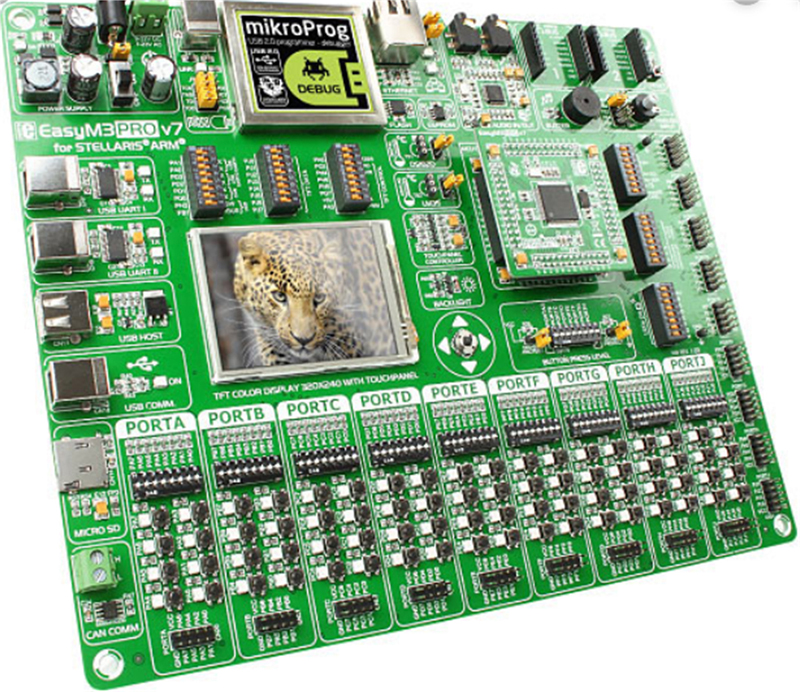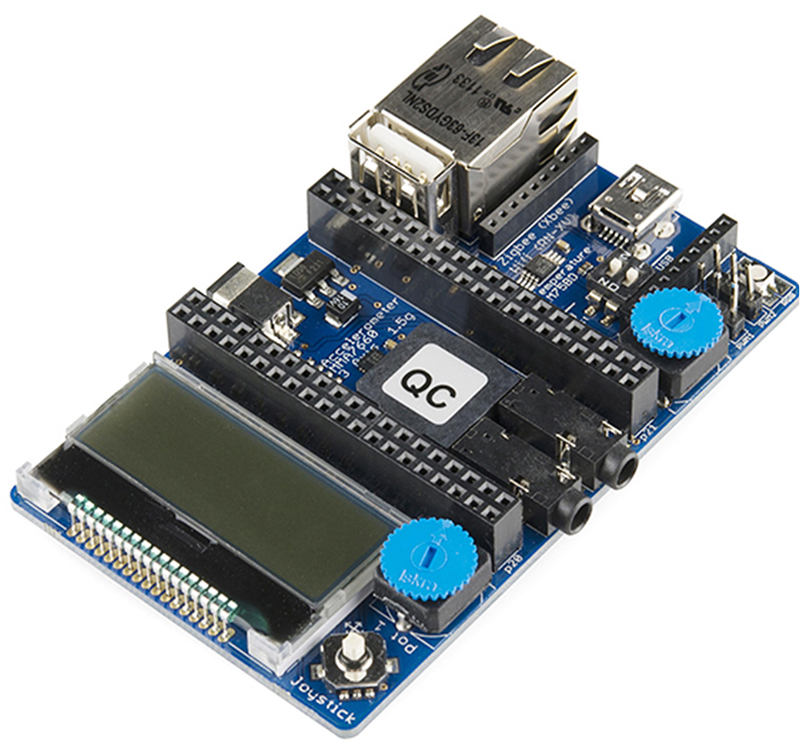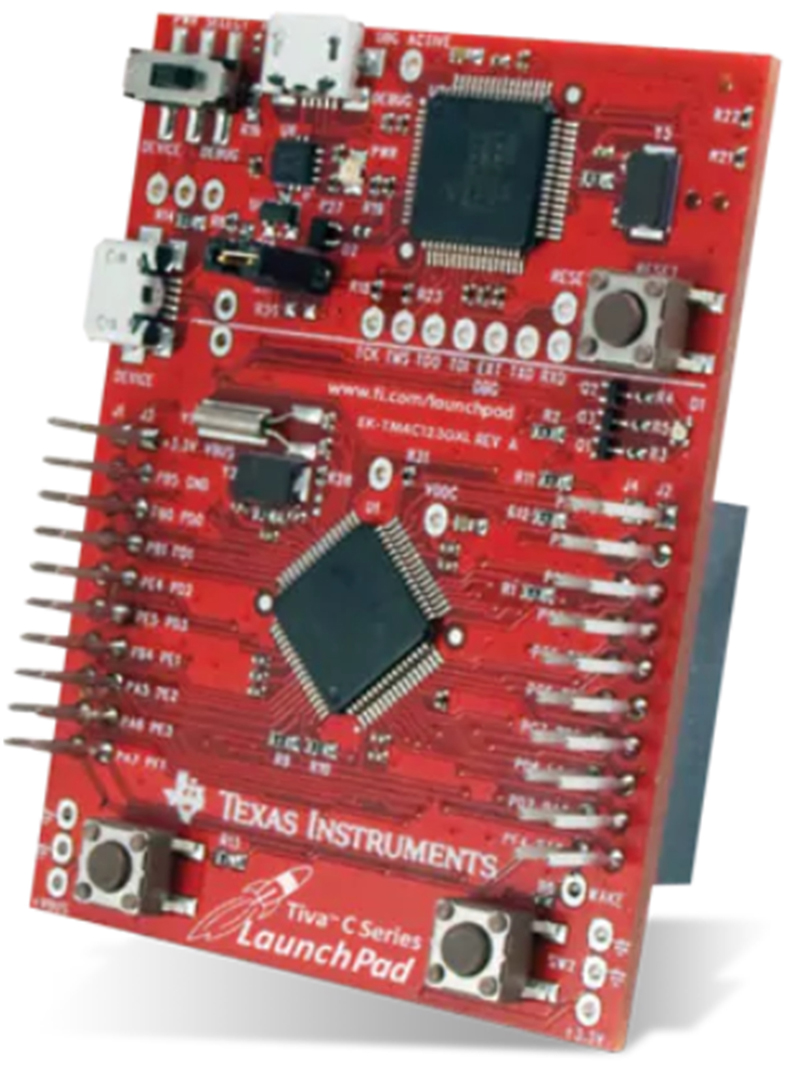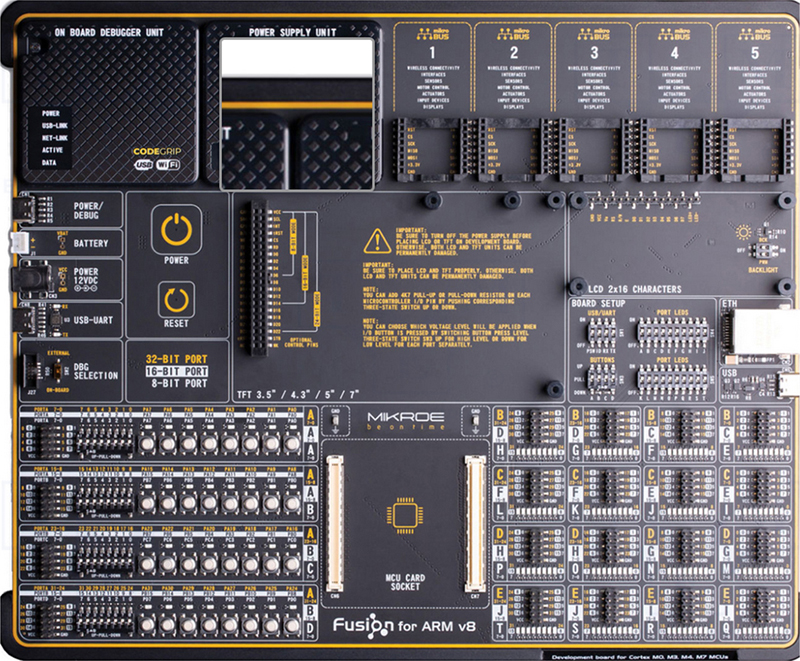Chapter 3
ARM Cortex microcontroller development boards
Abstract
Microcontroller development boards, also called development kits, help the system designers to develop and test projects easily and speedily. These boards incorporate the target microcontroller with usually additional memory, input-output ports, some LEDs, some switches, programmer, and some other peripheral interfaces such as UART, I2C, SPI, etc. Because the hardware of the development boards has been pretested by the manufacturers, the designer can concentrate on the software of the application, knowing that the hardware is in working order. This chapter describes some of the popular ARM Cortex microcontroller-based development boards. The basic features of the commonly used ARM processor development boards are described briefly.
Keywords
microcontroller development board
microcontroller development kit
ARM Cortex development boards
LPC1768
STM32 Nucleo family
STM32F discovery board
Clicker 2 ARM development board
fusion for ARM development board
3.1. Overview
Microcontroller development boards (or kits) help the system designers to develop projects easily and speedily. These boards incorporate the target microcontroller with usually additional memory, input-output ports, some LEDs, some switches, device programmer, and some other peripheral interfaces such as UART, I2C, SPI, etc. Because the hardware of the development boards has been tested by the manufacturers, the designer can concentrate on the software of the application, knowing that the hardware is in working order. In this chapter we shall be looking at the basic features of some of the popular ARM Cortex-based microcontroller development boards.
3.2. LPC1768
This is an Mbed compatible microcontroller, based on the Cortex-M3 processor (Fig. 3.1), having a form-factor of 40-pin DIP with 0.1 in. of spacing, and manufactured by NXP. The basic features of this development board are:
- • 32-bit 96 MHz processor
- • 32 KB SRAM, 512 KB flash
- • 12-bit ADC
- • 10-bit DAC
- • Ethernet
- • SPI, I2C, UART, PWM, CAN interfaces
- • breadboard compatible
- • USB or external power supply

3.3. STM32 Nucleo family
The family of STM32 Nucleo consists of many ARM Cortex-based Mbed compatible development boards with different specifications. For example, Nucleo-L476RG is one of the low-cost and very popular development boards (Fig. 3.2) in this family, having the following specifications:
- • 32-bit Cortex-M4 CPU
- • 80 MHz max CPU frequency
- • 1 MB Flash, 128 KB SRAM
- • 13 × Timers
- • 2 × Watchdog
- • 3 × SPI
- • 3 × I2C
- • 3 × USART, 2 × UART
- • CAN bus
- • 2 × SAI
- • 51 GPIO ports with external interrupt capability
- • 12 Channel capacitive sensing
- • 3 × 12-bit ADC with 16 channels
- • 12-bit DAC with 2 channels
- • 2 × analog comparators
- • 2 × Opamps
- • user LED and User push-button

Figure 3.2 Nucleo-L476RG development board. (©STMicroelectronics. Used with permission)
The Nucleo family of microcontrollers is supported by a large number of compatible and plug-in boards, such as Wi-Fi, Bluetooth, DC and stepper motor controller, temperature sensor, distance sensor, etc.
3.4. EasyMX Pro V7 For STM32
EasyMx PRO v7 for STM32 is a development board for STM32 ARM Cortex-M3 and Cortex-M4, M7, M0 architectures. It contains many on-board modules necessary for device development, including multimedia, Ethernet, USB, RS232, CAN interface, and others. On-board mikroProg programmer and debugger supports the programming and debugging of over 180 ARM-based microcontrollers. The board is fully supported and is compatible with the mikroC Pro for ARM compiler and IDE. EasyMx Pro V7 for STM32 is delivered with the microcontroller card containing the STM32F107VCT6. This development board, manufactured by mikroElektronika is a full-size board (Fig. 3.3), having the following specifications:
- • STM32F107VCT6 microcontroller
- • 72 MHz clock
- • 256 KB Flash, 64 KB SRAM
- • 5 × USB UART
- • Piezo buzzer
- • analog and digital temperature sensors
- • Ethernet
- • CAN
- • 2 × 12-bit ADC
- • 2 × 12-bit DAC
- • 2 × I2C
- • 2 × SPI
- • 2 × CAN
- • microSD card slot
- • stereo MP3 Codec
- • 8 Mbit serial flash
- • 8 × 256 Bytes EEPROM
- • 320 × 240 pixel Graphics TFT board
- • 128 × 64 pixel graphics LCD
- • 2 × microbus connectors
- • touch screen controller
- • 67 LEDs and 67 push-buttons
- • navigation switch
- • on-board programmer/debugger

3.5. STM32F4DISCOVERY board
This is another highly popular ARM-based development board used in many applications. This development board (Fig. 3.4) is based on the STM32F407VGT6 32-bit ARM Cortex-M4-based CPU, and it has the following basic specifications:
- • 1 Mb flash 192 KB SRAM
- • MEMS 3-axis accelerometer
- • MEMS audio sensor omnidirectional digital microphone
- • audio DAC with integrated class D speaker driver
- • 8 LEDs
- • 2 push-buttons
- • USB OTG FS with micro-AB connector
- • USB ST-LINK with re-enumeration capability, debug port, virtual com port, and mass storage

Figure 3.4 STM32FDISCOVERY board. (©STMicroelectronics. Used with permission)
3.6. mbed application board
This is a small size, but popular 32-bit ARM microcontroller (Fig. 3.5) based development board, designed for rapid prototyping, having the following specifications:
- • credit card sized
- • 128 × 32 graphics LCD
- • 5-way joystick
- • 3-axis MEMS accelerometer
- • temperature sensor
- • 2 × potentiometers
- • 5-way navigation switch
- • RGB LED
- • miniature loudspeaker
- • 2 × servo motor headers
- • headers for Xbee Zigbee module
- • mini USB connector
- • RJ-45 Ethernet socket
- • 6–9 V DC power socket

Figure 3.5 mbed Application board. (From SparkFun Electronics, Photo taken by Juan Peña)
The board requires the LPC1768 processor to operate, and with this processor it offers all the specifications of the LPC1768 (see Section 3.2).
3.7. EasyMx Pro V7 for Tiva
EasyMx PRO v7 for Tiva C Series is a full-featured development board (Fig. 3.6) for TI’s Tiva C Series ARM Cortex M4 microcontrollers. It contains many on-board modules necessary for developing a variety of applications, including multimedia, Ethernet, USB, RS232, CAN, and others. On-board mikroProg programmer and debugger supports over 55 TI Tiva C series microcontroller programming and debugging. The board is delivered with a microcontroller socket containing the TM4C129XNCZAD type Tiva microcontroller. The basic features of this board are:
- • 32-bit Cortex-M4 processor
- • 120 MHz clock
- • 1 MB flash, 256 KB SRAM
- • 6 KB EEPROM
- • 2 mikroBus sockets
- • 2 × USB UART
- • buzzer
- • 2 × CAN
- • 2 × 12-bit ADC
- • 8 × UART
- • 8 Timers
- • 2 × Watchdog timer
- • 16 × digital comparator
- • 8 M bit flash
- • Ethernet
- • 256 × 8 I2C EEPROM
- • stereo MP3 Codec
- • mikro SD card slot
- • 67 LEDs and 67 push buttons
- • 320 × 240 pixel graphics TFT
- • analog and digital temperature sensors
- • all I/O ports at headers

3.8. MINI-M4 for STM32
This is a small ARM Cortex-M4-based development board (Fig. 3.7) containing the STM32F415RG type microcontroller. It is equipped with 16 MHz crystal oscillator, and 32.768 KHz crystal which can be used for its internal RTCC module. It has a reset button and three signal LEDs. The board is preprogrammed with fast USB Bootloader, so no external programmers are needed for programming the microcontroller and for program development. The board is fully compatible with the mikroc Pro for ARM compiler and the IDE. The basic features of this board are:
- • 32-bit ARM Cortex-M4 processor
- • 1 MB flash, 192 + 4 KB SRAM
- • Up to 168 MHz operation
- • 7 × analog inputs
- • CAN
- • 4 × PWM channels
- • 2 × SPI
- • I2C
- • 2 × UART
- • 3 × 12-bit ADC
- • 2 × 12-bit DAC
- • 17 × Timers

3.9. Clicker 2 for MSP432
This board is based on the MSP432 32-bit Cortex-M4–based processor (Fig. 3.8). The board supports two mikroBUS sockets so that up to two Click Boards can be plugged-in to the board. The basic features of this development board are:
- • 48 MHz clock
- • 256 KB flash, 64 KB SRAM
- • 6 timers
- • SPI
- • I2C
- • 2 LEDs
- • 2 push-button switches
- • 52 general purpose GPIO
- • 2 × mikroBUS sockets
- • on-chip Bootloader
- • mikro-USB connector
- • power management

3.10. Tiva EK-TM4C123GXL LaunchPad
This is a low-cost development board (Fig. 3.9) based on ARM Cortex-M4, using the TM4C123GH6PMI microcontroller. The basic features of this board are:
- • 32-bit ARM processor
- • 80 MHz clock
- • 256 KB flash, 32 KB SRAM
- • 2 × CAN modules
- • 8 × UARTs with IrDA
- • 2 × 12-bit ADC with 12 channels
- • 2 × analog, 16 × digital comparators
- • 12 × 16-bit Timers
- • 43 × general purpose GPIO
- • RGB LED
- • reset switch
- • motion control PWM

Figure 3.9 Tiva EK-TM4C123GXL. (Courtesy of Texas Instruments Inc.)
3.11. Fusion for ARM V8
This is an advanced state-of-the-art development board designed for ARM-based microcontrollers (Fig. 3.10). The board supports over 1600 types of ARM-based processors and it has the unique feature that it can be used and programmed/debugged remotely over a Wi-Fi link. The board is suitable for all kinds of microcontroller-based project development as it provides a large number of switches, LEDs, LCD, and graphical TFT sockets, CAN bus, UARTs, etc. By default, the board is distributed with the STM32F407ZG microcontroller. The basic features of this board are (with the default processor):
- • 32-bit ARM processor support
- • 1 MB flash, 192 + 4 KB SRAM
- • 168 MHz clock
- • 3 × 12-bit ADC with 24 channels
- • 2 × 12-bit DAC
- • 17 Timers
- • up to 140 I/O ports
- • 3 × I2C
- • 4 × UART
- • 3 × SPI
- • 2 × CAN
- • up to 800 × 480 pixel TFT support
- • 1 × 16 pin LCD connector
- • 5 × mikroBUS connectors
- • CODEGRIP programmer/debugger, enabling programming, and debugging over a Wi-Fi link
- • large number of configurable LEDs and push-button switches
- • UART connectivity over USB-C
- • Up-pull-down switches
- • 2 × 5-pin I/O headers

The novelty of this board is that at the time of writing this book, this was the first development board that could be programmed/debugged over a Wi-Fi link.
3.12. Clicker 2 for STM32
This is a low-cost highly popular development board based on the 32-bit ARM processor STM32F407VGT6. This board is equipped with two mikroBUS sockets so that up to two Click Boards can be plugged-in to the board. The board features a mini USB port for connection to a PC. A Bootloader program is preloaded in the program memory of the microcontroller. A PC-based Bootloader program is available from the manufacturer (www.mikroe.com) so that the processor can easily be programmed with the user application program.
This is the development board used in all the projects in this book and full details of this board are described in Chapter 4.
3.13. Summary
In this chapter we have looked at some of the popular ARM processor-based development boards and studied the basic features of these boards. In this book we will be using the Clicker 2 for STM32 development board in all the projects. In the next chapter we will be looking at the basic architecture of the Clicker 2 for STM32 development board and the STM32F407VGT6 processor used on this board.
..................Content has been hidden....................
You can't read the all page of ebook, please click here login for view all page.
